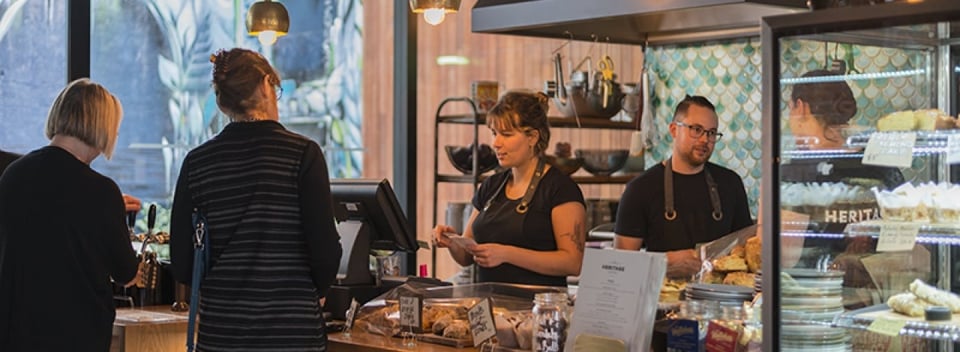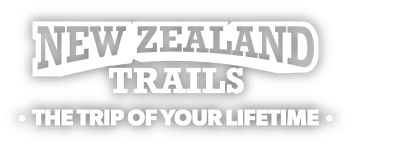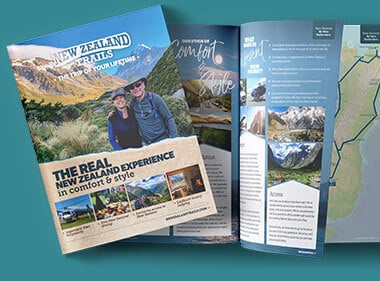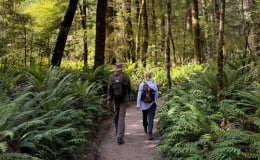
Guide to New Zealand’s Coffee Culture

Since that first recorded sip of this aromatic brown liquid in the fourteenth century, through to today’s café culture, coffee has become a staple (and for some a necessity) in many pantries around the world, and New Zealand is no exception.
Coffee has become a huge part of daily life in New Zealand and no trip here would be complete without experiencing the joy of a flat white or long black in one of our many incredible local cafes. Trying new things is always a memorable part of any adventure and our New Zealand hiking tours are no exception. We love sharing our favourite local drops with our guests as well as other distinctly New Zealand delicacies as we explore the best of our beautiful country.
A short history of New Zealand coffee culture
No one seems to know exactly where coffee originated in Africa, but many believe it was Ethiopia, which is still a major player on the coffee producing circuit (around 384,000 metric tons or 846,575,000 pounds produced annually). Coffee has exploded on a global scale since its introduction to Europe in the mid-1600’s.
Coffee has been in New Zealand since Europeans first arrived, but being so far away from everywhere we had to get a little inventive. And while instant coffee wasn’t a new concept, New Zealander David Strang from Invercargill, invented the first truly instant or soluble coffee in 1890.
New Zealand was a little late to the coffee culture scene and, taking inspiration from our espresso-drinking Italian friends, these machines started popping up in cafés and tearooms across the country from about the mid-1980’s. But as with many things, we took it and ran with it, and now we are known as one of the best coffee making countries in the world.
Fun New Zealand coffee facts
- Our capital city, Wellington, has more cafés per capita than New York City.
- You won’t find a drip coffee in New Zealand - sorry about that!
- Most kiwi homes will sport a French press/plunger if they don’t have an espresso machine.
- The method of making espresso results in a stronger coffee with bolder flavours than drip coffee – this can offer a real kick for anyone unaccustomed to drinking espresso, be warned!
- All New Zealand coffee starts with the exact same espresso shot (quite often a double shot); this means that you will be getting the same amount of caffeine regardless of what style of coffee you order unless you specify otherwise.
- Reusable cups are encouraged in New Zealand, with most takeaway cups globally unable to be recycled.
- Per capita, our coffee consumption rate is in the top 20 in the world, just ahead of the USA.
- New Zealand has a coffee festival, held in Auckland during March every year.
- Latte art has found a foothold across the globe with creative baristas showcasing their skills. New Zealand loves the fern design, to represent the iconic Silver Fern.

The Silver Fern, a latte art staple in cafes around New Zealand.
What constitutes a great coffee?
What constitutes great art? Coffee is subjective and as such, if it tastes great to you, it’s a great coffee.
Coffee should taste like coffee; fresh and aromatic, like it came from a bean off a tree. If your coffee tastes burnt, it probably is, likewise if your coffee tastes stale. Everything else is to the taste of the individual, so don’t let the self-professed coffee connoisseurs tell you your favourite brew is no good – if you love it, that’s all that matters.
Disseminating New Zealand’s coffee menu
Not sure what to order from our range? Have a look over the menu below to get an idea of what you might like, or have fun and try them all – just maybe not all at once!

The difference between an Americano and a Long Black
While these two drinks may seem the same at first glance, there are some discernible differences. Pouring twice the amount of hot water over a shot of espresso makes an Americano, while a Long Black is produced in the opposite way. It is very important in the making of a Long Black that the espresso (or ristretto) is poured over the hot water. This retains the crema and makes the coffee less voluminous and therefore stronger in flavour.

The base of all New Zealand coffees, a decent shot of espresso!
If you want your coffee a little more like what you would have at home, you can order either an Americano or Long Black with milk on the side. This is a great option for those who aren't so keen on foamy and/or warm milk.
The world famous Flat White
Just like the Pavlova dessert, there are arguments between Australia and New Zealand regarding who invented the Flat White – nothing like a little trans-Tasman rivalry to get the blood pumping.
With arguments and ‘proof’ on both sides, it’s hard to decide. Australian Alan Preston claims that in 1985 he invented the Flat White at his Sydney café, the Moors Espresso Bar, claiming his inspiration was from Queensland cafés that in the 60’s and 70’s advertised White Coffee – Flat.
On the opposite side of the Tasman here in little old New Zealand, kiwi barista Frank McInnes claims to have invented the Flat White after botching a cappuccino at Wellington’s Café Bodega in 1989. Not able to get the milk to froth, McInnes apologised to his customer, saying ‘sorry – it’s a Flat White’.
Since the 90’s the Flat White from ‘down under’ has become a staple in cafés around the UK and USA, including Starbucks – who inadvertently began this origin war by calling it an Australian coffee.
Regardless of the origin, the Flat White continues to be a fan favourite in New Zealand. Offering up a drink that is stronger than a latte and smoother than a cappuccino, this middle ground is what has made it so incredibly popular both in Australia and New Zealand, as well as across the globe.
How to fit in – the social situation
New Zealand still has a few traditions retained from our days as a British colony, and having ‘tea breaks’ in the morning and afternoon (fondly known as morning or afternoon tea) is one of them. These days, busy workers in cities throughout New Zealand throng to cafés lining the streets to get their caffeine fix. This is a very social occasion, catching up with friends or co-workers and as such the idea of Wi-Fi in a café hasn’t caught on here, it’s more of an afterthought. So, if you visit New Zealand and wonder about the slower internet speeds, just know that it hasn’t become as much of a social necessity in New Zealand as it has in other countries. Maybe it’s time to strike up a conversation with that stranger next to you… just another very kiwi quirk, so don’t be surprised if someone does try to start a conversation over a ‘cuppa’ while you are here.

Cafe culture in New Zealand is a social time, catching up with friends or co-workers over a coffee.
So, if you want to jump right into New Zealand’s café culture, there are a few things to remember:
- You won't find drip coffee here
- Be prepared that the Wifi speed may not blow your socks off
- Cafés are a great place to make new friends
- Bring your reusable cup (optional)
- Savour your coffee for the best experience
- The only place you will get a triple, venti, half-sweet, non-fat, caramel macchiato is Starbucks (they sell flat whites there too – just saying)
So, if you plan to travel to New Zealand or are already here, head down to a local café and enjoy a delicious cup of coffee, and soak up the relaxed and social nature of our Kiwi Coffee Culture.
Let our guides show you their favourite New Zealand coffee haunts. Check our trip schedules and availability on our availability page. To work out which trip suits you best, check out Which Trip is Right For Me.
Request your FREE NEW ZEALAND BROCHURE here now for articles, stories and information on our five guided trip options.
Other articles you may like:
- Kiwi hospitality and the New Zealand way
- A guide to New Zealand's wine regions
- We bet you’ve never heard of these 3 dream places to stay in New Zealand
- North vs South: Which Island of New Zealand Should I Visit?
- Get your free New Zealand Trails guided tour brochure








